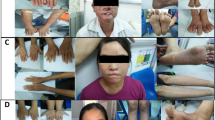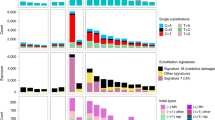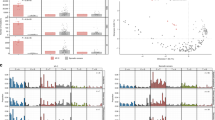Abstract
Xeroderma pigmentosum (XP) is an autosomal recessive disease. Cells cultured from XP patients are hypersensitive to the lethal effects of UV light1–6. Most XP cells are defective in an early stage in DNA repair of UV light-induced damage. The nature of the genetic defect of the XP syndrome has not been defined. To address this problem, we attempted to isolate UV-resistant cells from a cell line derived from an XP complementation group A (XPA) patient. By using a selection scheme capable of detecting one UV-resistant cell in a population of 108 cells, several UV-resistant clones were isolated at frequencies between 1 × 10−7 and 2 × 10−8. Here we describe the isolation and initial characterization of these phenotypic revertants.
This is a preview of subscription content, access via your institution
Access options
Subscribe to this journal
Receive 51 print issues and online access
$199.00 per year
only $3.90 per issue
Buy this article
- Purchase on Springer Link
- Instant access to full article PDF
Prices may be subject to local taxes which are calculated during checkout
Similar content being viewed by others
References
Cleaver, J. E. & Bootsma, D. A. Rev. Genet. 9, 19–38 (1975).
Robbins, J. H. J. natn. Cancer Inst. 61, 645–656 (1978).
Setlow, R. B. Nature 271, 713–717 (1978).
Friedberg, E. C., Ehman, V. K. & Williams, J. I. Adv. Radiat. Biol. 8, 85–174 (1979).
Arlett, C. F. & Lehmann, A. R. A. Rev. Genet. 12, 95–115 (1978).
Cleaver, J. E. Int. J. Radiat. Biol. 18, 557–565 (1970).
Royer-Pokora, B., Peterson, W. Jr & Haseltine, W. Expl Cell Res. 151, 408–420 (1984).
Takano, T., Noda, M. & Tamura, T. Nature 296, 269–270 (1982).
Lytle, C. D., Aaronson, S. A. & Harvey, E. Int. J. Radiat. Biol. 22, 159–165 (1972).
Abrahams, P. J. & Van der Eb, A. J. Mutat. Res. 35, 13–22 (1976).
Riazuddin, S. & Grossman, L. Biol. Chem. 252, 6280–6286 (1977).
Sutherland, B. H. & Shih, A. G. Biochemistry 22, 745–749 (1983).
Ganesan, A., Spivak, G. & Hanawalt, P. in Manipulation and Expression of Genes in Eukaryotes (eds Nagely, P., Linnane, A., W., Peacock, W. J. & Pateman, T. A. (Academic, Australia, 1982).
Thielmann, H. W. et al. Int. J. Cancer 31, 687–700 (1983).
Grusella, T. F. et al. Proc. natn. Acad. Sci. U.S.A. 77, 2829–2833 (1980).
Author information
Authors and Affiliations
Rights and permissions
About this article
Cite this article
Royer-Pokora, B., Haseltine, W. Isolation of UV-resistant revertants from a xeroderma pigmentosum complementation group A cell line. Nature 311, 390–392 (1984). https://doi.org/10.1038/311390a0
Received:
Accepted:
Issue Date:
DOI: https://doi.org/10.1038/311390a0
This article is cited by
-
Identification of human genes involved in repair and tolerance of DNA damage
Radiation and Environmental Biophysics (1991)
-
Ataxia telangiectasia resists gene cloning: An account of parameters determining gene transfer into human recipient cells
Molecular and General Genetics MGG (1988)
Comments
By submitting a comment you agree to abide by our Terms and Community Guidelines. If you find something abusive or that does not comply with our terms or guidelines please flag it as inappropriate.



